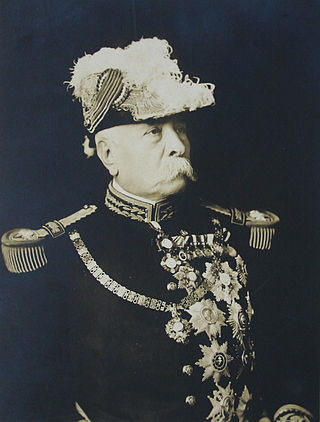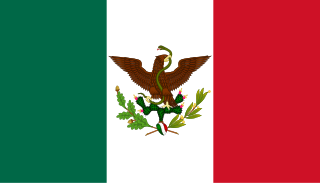
José de la Cruz Porfirio Díaz Mori, known as simply Porfirio Díaz, was a Mexican general, politician, and later dictator who served on three separate occasions as President of Mexico, a total of over 30 years, from 28 November 1876 to 6 December 1876, 17 February 1877 to 1 December 1880, and 1 December 1884 to 25 May 1911. The entire period from 1876 to 1911 is often referred to as the Porfiriato, and has been characterized as a de facto dictatorship.

The Papaloapan River is one of the main rivers of the Mexican state of Veracruz. Its name comes from the Nahuatl papaloapan meaning "river of the butterflies".

Sebastián Lerdo de Tejada y Corral was a Mexican liberal politician and jurist who served as the 27th president of Mexico from 1872 to 1876.

The governor of Querétaro is the chief executive of the Mexican state of Querétaro. According to the Constitution of the Free and Sovereign State of Queretaro, the exercise of executive power of the Mexican state, is deposited in one individual, it called the Constitutional Governor is elected for a period of six years no re-eligible for any reason. The governmental period begins on October 1 of the year of the election and ends on September 30 after six years have elapsed. Queretaro state was created in 1824, one of the original states of the federation, thus throughout its historical life has passed by all systems of governance found in Mexico, both federal system as the central system, so the name of the organization has varied between been and department; changing along with it, the name of the head of the Executive branch of government.
Sexenio is the popular term for the term of office on the President of Mexico. Under Article 83 of the Mexican Constitution, the president is limited to a single six-year term, and no one who holds the office even on a caretaker basis is permitted to run for or hold the office again. It is one of the country's most important political institutions, because it is one of the few significant limitations on executive power in Mexico, which is strong at local, state, and national levels. The sexenio is a reaction to the failed experiment of re-election in Mexico during part of the Porfiriato era (1876–1911).

The Porfiriato is a term given to the period when General Porfirio Díaz ruled Mexico as president in the late 19th and early 20th centuries, coined by Mexican historian Daniel Cosío Villegas. Seizing power in a coup in 1876, Díaz pursued a policy of "order and progress," inviting foreign investment in Mexico and maintaining social and political order, by force if necessary. There were significant economic, technological, social, and cultural changes during this period.

José María Iglesias Inzáurraga was a Mexican lawyer, professor, journalist and liberal politician. He is known as author of the Iglesias law, an anticlerical law regulating ecclesiastical fees and aimed at preventing the impoverishment of the Mexican peasantry.

Juan Nepomuceno Méndez Sánchez was a Mexican general, a Liberal politician and confidant of Porfirio Díaz, and interim president of the Republic for a few months during the Porfiriato. He served from 6 December 1876 until 17 February 1877.

San Juan Bautista Tuxtepec, or simply referred to as Tuxtepec, is the head of the municipality by the same name and is the second most populous city of the Mexican state of Oaxaca. It is part of the Tuxtepec District of the Papaloapan Region. As of the 2020 census, the city is home to a population of 103,609 and 159,452 in the municipality, though census data are often under reported for various reasons.
In Mexican history, the Plan of Tuxtepec was a plan drafted by General Porfirio Díaz in 1876 and proclaimed on 10 January 1876 in the Villa de Ojitlán municipality of San Lucas Ojitlán, Tuxtepec district, Oaxaca. It was signed by a group of military officers led by Colonel Hermenegildo Sarmiento and drafted by porfiristas Vicente Riva Palacio, Ireneo Paz, and Protasio Tagle on the instigation of Díaz. Díaz signed the previous version of the plan in December 1875, which did not include the three most important articles that appointed Diaz as president. It disavowed Sebastián Lerdo de Tejada as President, while acknowledging the Constitution and the Reform laws, and proclaimed Díaz as the leader of the movement. Díaz later became the president of Mexico, ushering in a period known as the Porfiriato.
Donato Guerra is one of 125 municipalities in the State of Mexico, Mexico. It's municipal seat is the town of Villa Donato Guerra, which is the 13th largest town in the municipality of Donato Guerra. The area is also known as Malacatepec and La Asunción Malacatepec. (Villa) Donato Guerra is located in the western part of the State of Mexico. In the region that is identified with Valle de Bravo. The town was named in 1880 in honor of Donato Guerra, a distinguished soldier of the War of La Reforma. It is located around 77 kilometers from Toluca which is the capital of the state, on Federal Highway number 35 Mexico City - Zitácuaro.
Protasio Tagle was a Mexican soldier and politician who lived in the 19th century.

José Cevallos Cepeda was a Mexican politician and military leader.

Diódoro Corella was a Mexican general and the Governor of San Luis Potosí from 1872 to 1873. Corella was a liberal and strongly opposed French Intervention in Mexico, being exiled by the conservative government. He returned to Mexico upon the victory of Benito Juárez and fought against Porfirio Díaz when he tried to seize power. In 1871, he fought against the Uprising of Tamaulipas, and in 1872, he headed a cavalry division with the rank of colonel general and then brigade general; that year he fought Jerónimo Treviño's forces in the Battle of Monterrey with, according to Juan E. Guerra, 4,000 men. In early 1876, he was in Santo Domingo Yanhuitlán suppressing the Revolution of Tuxtepec, a second uprising by Díaz, and on 2 June, he was reported as wounded from battle. His remains were interred on 17 July 1876 at the Rotunda of Illustrious Persons.

In the history of Mexico, the Plan de la Noria was a revolutionary call to arms intended to oust President Benito Juárez, who had been elected to a fourth term. Liberal General Porfirio Díaz issued it on 8 November 1871, immediately following his defeat by Juárez in the presidential election. Neither Juárez, Díaz, nor the third candidate, Sebastián Lerdo de Tejada, won a majority of votes. As a result, the Mexican Congress had to choose the victor; it was dominated by Juáristas and elected Juárez to his fourth term.

The Restored Republic was the era of Mexican history between 1867 and 1876, starting with the liberal triumph over the Second French Intervention in Mexico and the fall of the Second Mexican Empire and ending with Porfirio Diaz's ascension to the presidency. It was followed by the three-decade dictatorship known as the Porfiriato.

Presidential elections were held in Mexico in 1877. They followed the overthrow of President Sebastián Lerdo de Tejada at the end of 1876 as part of the Plan of Tuxtepec. The result was a victory for Porfirio Díaz, who received 96% of the vote.

General elections were held in Mexico in 1876. Incumbent president Sebastián Lerdo de Tejada was re-elected with over 90% of the vote. However, he was removed from office by the end of the year as a result of the Plan of Tuxtepec.

José Jerónimo de los Dolores Treviño y Leal, commonly known as Jerónimo Treviño was a prominent Mexican General and politician. He was a veteran of the Reform War and the Second French intervention in Mexico which he gained fame for his participation in several battles. After the fall of the Second Mexican Empire, Treviño served as the Governor of Nuevo León on several terms as well as the Secretary of War and Navy of Mexico from December 1, 1880, to December 31, 1881, under the cabinet of Manuel González Flores.













